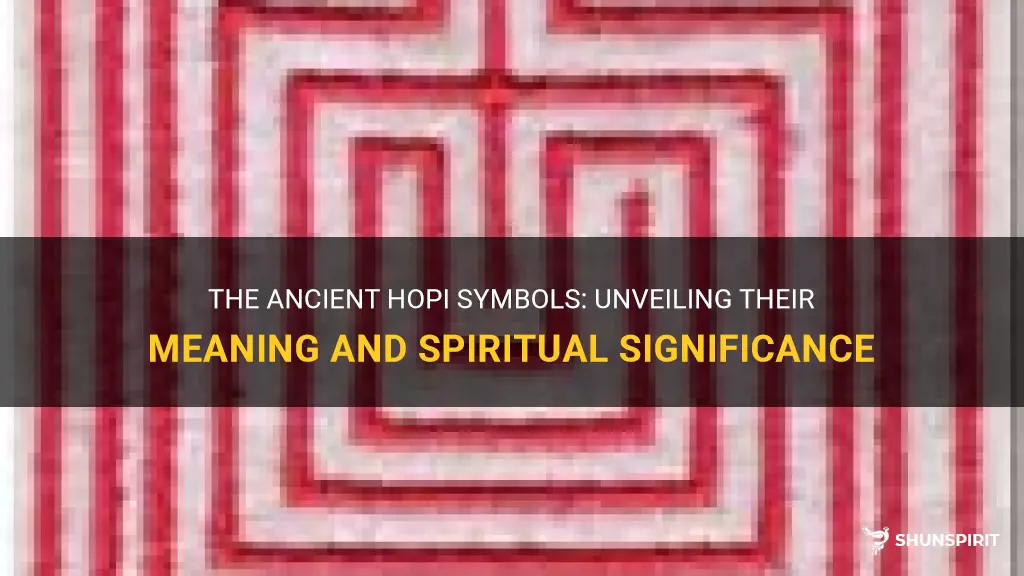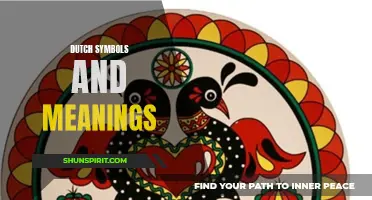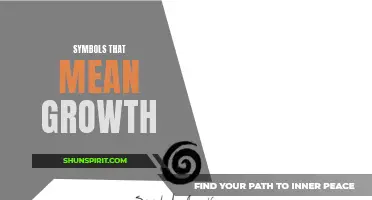
The Hopi Native American tribe has a rich cultural history and their symbols hold deep meaning and significance. These symbols are not only beautiful works of art but also serve as a language for the tribe, used to communicate their beliefs, stories, and traditions. Each symbol tells a story, representing elements of nature, spirituality, and lessons passed down through generations. Exploring the world of Hopi symbols unveils a fascinating insight into their culture and offers a window into the spiritual and symbolic landscape of this ancient tribe.
What You'll Learn
- What are some common Hopi symbols and what do they represent?
- How do Hopi symbols differ from symbols used by other Native American tribes?
- Are there any symbols that are considered particularly important or sacred in Hopi culture?
- What is the significance of color in Hopi symbols?
- How have Hopi symbols been incorporated into contemporary Native American art and design?

What are some common Hopi symbols and what do they represent?
The Hopi Native American tribe has a rich cultural heritage that is deeply intertwined with symbolism. Through their art, ceremonies, and daily life, Hopi symbols are used to convey important messages and meanings. Here are some common Hopi symbols and what they represent:
- Kachinas: Kachinas are supernatural beings who are believed to bring rain, fertility, and good fortune to the Hopi people. Kachina dolls, which are carved by Hopi artisans, represent specific kachinas and are used in ceremonies to invoke their powers.
- Corn Maiden: The Corn Maiden symbolizes fertility, abundance, and harvest. She is often depicted as a woman holding ears of corn and is associated with the growth and sustenance of the Hopi people.
- Sunface: The Sunface symbol represents the sun and its life-giving energy. It is often depicted as a circle with radiating lines or as a face with a radiant headdress. The Sunface symbolizes light, warmth, and the continuous cycle of life.
- Water Symbol: Water is considered a sacred element in Hopi culture. The water symbol is often depicted as a wave or a series of parallel lines and represents purity, life, and the vital role of water in sustaining the Hopi people.
- Animal Symbolism: Various animals hold special significance in Hopi symbolism. For example, the eagle symbolizes strength, courage, and spiritual power, while the bear represents healing, protection, and wisdom. Animals are seen as spirit guides and are often depicted in Hopi artwork and ceremonies.
- Butterfly: The butterfly symbolizes transformation and metamorphosis. It represents the cycle of life and death and is associated with spiritual growth and rebirth. The butterfly is often depicted in Hopi pottery and textiles.
- Spirals: Spirals are common symbols in Hopi art and represent life's journey and cyclical nature. The spiral symbolizes growth, change, and the interconnectedness of all living things. It is often seen in Hopi pottery designs and sand paintings.
- Maze or Labyrinth: The maze or labyrinth symbol is called "Tawa Maze" in Hopi culture. It represents the challenges and choices of life's journey. The labyrinth symbolizes the various paths one can take and the need for self-reflection and decision-making.
These are just a few examples of the many symbols used by the Hopi Native American tribe. Each symbol carries a deep cultural and spiritual meaning and is an integral part of the Hopi way of life. By understanding these symbols, we gain insights into the values, beliefs, and traditions of the Hopi people.
Exploring the Fascinating Symbolism of the Black Diamond
You may want to see also

How do Hopi symbols differ from symbols used by other Native American tribes?
Hopi symbols are unique and distinct from symbols used by other Native American tribes. The Hopi people have a rich culture and tradition that is reflected in their symbols, which hold deep spiritual and cultural significance.
One major difference between Hopi symbols and symbols used by other tribes is the way they are interpreted and understood. While many Native American tribes use symbols to represent various aspects of their culture, the Hopi symbols are often more abstract and open to individual interpretation. This is because the Hopi people believe that symbols are a form of communication between the spiritual and physical realms.
The Hopi symbols are often geometric shapes or abstract designs that convey messages and meanings. These symbols can represent nature, animals, spirits, and various aspects of daily life. They are used in ceremonies, rituals, and artwork to convey important teachings and spiritual concepts.
Another difference is the use of color in Hopi symbols. The Hopi people have a unique and vibrant color palette that is used in their symbols. The colors used have specific meanings and represent different elements of the natural world. For example, yellow represents the sun and warmth, while blue represents the sky and water.
Hopi symbols are also known for their intricate and detailed designs. The symbols are often made up of multiple layers and patterns, each with its own meaning. These intricate designs require skill and precision to create, and they serve as a visual representation of the complex spiritual and cultural beliefs of the Hopi people.
In addition, Hopi symbols often convey deeper meanings and messages that go beyond their literal interpretation. They are meant to be contemplated and meditated upon, allowing individuals to connect with the spiritual realm and gain wisdom and insight.
It is important to note that while Hopi symbols may differ from symbols used by other Native American tribes, each tribe has its own unique symbols and cultural traditions. Each symbol carries its own significance and holds a special place within the culture and spirituality of its respective tribe.
In conclusion, Hopi symbols are distinct and unique from symbols used by other Native American tribes. They are abstract and open to interpretation, often incorporating intricate designs and vibrant colors. These symbols are a form of communication between the spiritual and physical realms, conveying deep meanings and messages. Understanding and appreciating the Hopi symbols allows individuals to gain insight into the rich cultural and spiritual heritage of the Hopi people.
Discovering the Meanings of Symbols Associated with Balance
You may want to see also

Are there any symbols that are considered particularly important or sacred in Hopi culture?
Symbols play a crucial role in the Hopi culture. They are not only used for communication and storytelling but are also considered sacred and hold deep spiritual significance. The Hopi people have a rich tradition of symbolism that has been passed down from generation to generation.
One of the most important symbols in Hopi culture is the Kachina. Kachinas are powerful spirits that represent supernatural beings and ancestral spirits. They are believed to mediate between the human and spiritual realms and play a crucial role in the Hopi religious ceremonies. Kachinas are usually depicted as elaborate, colorful masks and costumes worn by dancers during religious ceremonies. Each Kachina has its own unique symbolism and is associated with specific virtues and powers. The Kachina dolls are also widely known and highly valued by collectors and art enthusiasts around the world.
Another important symbol in Hopi culture is the Spiral. The Spiral represents the journey of life, with its continuous cycles of birth, growth, death, and rebirth. The spiral is often seen in Hopi pottery and basketry, as well as in other forms of Hopi artwork, such as jewelry and paintings. It is believed that the spiral symbolizes the cyclical nature of the universe and reminds the Hopi people of their connection to the natural world and the harmony of all living beings.
The Sun is also a significant symbol in Hopi culture. The Hopi people believe that the Sun is not only a source of light and warmth but also a powerful spiritual force. The Sun symbolizes fertility, growth, and the life-giving energy that sustains all living beings. It is often depicted in Hopi artwork, as well as in religious ceremonies and rituals.
Another important symbol in Hopi culture is the Corn. Corn is considered a sacred plant and is the cornerstone of Hopi agriculture and sustenance. It symbolizes abundance, nourishment, and the interdependence of all living things. The Hopi people believe that the Corn Maiden, a powerful ancestral spirit, is responsible for the fertility and growth of the corn. Corn is often depicted in Hopi pottery, jewelry, and other forms of artwork.
The Labyrinth is also considered a sacred symbol in Hopi culture. The labyrinth represents the journey of life and the spiritual path that leads to enlightenment and self-discovery. It is often used in Hopi religious ceremonies and rituals as a tool for meditation and prayer.
These are just a few examples of the symbols that hold great importance and sacredness in the Hopi culture. Each symbol carries its own unique meaning and is an integral part of the Hopi people's spiritual and cultural identity. The use of these symbols in artwork, ceremonies, and daily life serves to reinforce the deep connection and reverence that the Hopi people have for their traditions and spiritual beliefs.
What Does the Car Symbol with an Arrow Mean and How to Interpret It
You may want to see also

What is the significance of color in Hopi symbols?
The Hopi tribe, one of the oldest Native American tribes in the United States, has a rich cultural heritage that is deeply rooted in spirituality and symbolism. One of the most prominent features of Hopi art and symbolism is the use of color. Color holds great significance in Hopi symbols, and each color represents different aspects of their beliefs and values.
In Hopi culture, colors are not simply used for aesthetic purposes. They hold deep spiritual meanings and are closely associated with various elements, deities, and natural phenomena. The Hopi people believe that colors possess spiritual powers and can influence different aspects of life.
One of the most important colors in Hopi symbols is yellow, which represents the sun. The sun is central to Hopi cosmology and is associated with life, growth, and prosperity. The color yellow also symbolizes clarity, enlightenment, and spiritual awakening.
Blue is another essential color in Hopi symbols, representing the sky and the heavens. The sky is seen as a sacred realm in Hopi culture, and it is believed to be inhabited by powerful deities. Blue also symbolizes calmness, peace, and harmony.
Red is a color that is associated with the earth and represents the physical world. It symbolizes energy, strength, and endurance. Red is often used in Hopi symbols to represent the earth's fertility and the life-giving forces of nature.
Green is a color that represents nature and the plant kingdom. It symbolizes growth, renewal, and vitality. Green is often used in Hopi symbols to represent the abundance and prosperity that comes from a harmonious relationship with the natural world.
White is a color that symbolizes purity, innocence, and spiritual cleansing. It is often used in Hopi symbols to represent purity of thought, word, and action. White is also associated with the winter season, when the earth rests and prepares for new growth.
Black is a color that represents the unknown, mystery, and the spirit realm. It is often used in Hopi symbols to represent the unseen forces that influence the physical world. Black is also associated with the night and is seen as a time of rest, reflection, and spiritual rejuvenation.
In addition to these primary colors, the Hopi use various combinations and shades of colors in their symbols to convey different meanings. The specific colors used in a symbol can vary depending on the artist's interpretation and the intended message of the symbol.
Overall, the use of color in Hopi symbols plays a crucial role in conveying the tribe's deep spiritual beliefs and values. Each color carries specific meanings and associations that reflect the Hopi people's strong connection to nature, the spirit realm, and the cosmic forces that govern their world. By understanding the significance of color in Hopi symbols, one can gain a deeper appreciation for the richness and complexity of their culture.

How have Hopi symbols been incorporated into contemporary Native American art and design?
Hopi symbols hold deep cultural significance and are an integral part of the Native American Hopi tribe's history and identity. These symbols have been passed down through generations and continue to be incorporated into contemporary Native American art and design. They serve as a means of storytelling, conveying messages, and connecting with the Hopi culture and its traditions.
One of the prominent ways Hopi symbols are incorporated into contemporary Native American art is through pottery. The Hopi are famous for their intricate and beautiful pottery, which often features symbolic representations. These symbols can represent various natural elements such as animals, crops, and celestial bodies. The intricate designs are created by skilled artisans, using traditional techniques and materials.
In addition to pottery, Hopi symbols can be found in various other forms of contemporary Native American art, such as painting, jewelry, weaving, and sculpture. Many Native American artists draw inspiration from the rich symbolism of the Hopi tribe and incorporate these symbols into their works. For example, paintings may feature symbolic animals or plants, while jewelry may be adorned with intricate Hopi designs.
Contemporary Native American designers also make use of Hopi symbols in their fashion and textile designs. Traditional Hopi patterns and motifs are often incorporated into clothing, accessories, and home decor items. These designs not only showcase the beauty of Hopi symbolism but also serve as a way to promote cultural pride and awareness.
Moreover, Hopi symbols have even made their way into contemporary graphic design and digital art. Native American artists and designers use modern technology and techniques to create digital representations of traditional Hopi symbols. These digital artworks can be printed on various merchandise, such as posters, t-shirts, and mugs. This allows for a wider reach and enables people from diverse backgrounds to appreciate and connect with Hopi symbolism.
The incorporation of Hopi symbols into contemporary Native American art and design serves multiple purposes. It helps preserve and revive the rich cultural heritage of the Hopi tribe, ensuring that these symbols and their meanings are not forgotten. Furthermore, it allows Native American artists to express their identity and create meaningful works that resonate with both Native and non-Native audiences.
In conclusion, Hopi symbols play a significant role in contemporary Native American art and design. They are incorporated into various art forms, including pottery, painting, jewelry, weaving, sculpture, fashion, and graphic design. These symbols serve as a means to preserve the cultural heritage of the Hopi tribe, while also allowing Native American artists to express their identity and promote cultural awareness. The incorporation of Hopi symbols into contemporary art and design serves as a bridge between the past and the present, connecting generations and fostering a deeper understanding of Native American culture.
Frequently asked questions
The Hopi symbols represent different aspects of the Hopi culture, religion, and daily life. Each symbol has a specific meaning and is used to convey certain messages or concepts.
Hopi symbols are often incorporated into Hopi art, such as pottery, katsina dolls, and weaving. These symbols are used to tell stories, convey messages, and connect the artwork to the Hopi culture and traditions.
Yes, there are several Hopi symbols that are more commonly used in Hopi art and culture. Some of these include the sun symbol, corn symbol, rain symbol, and migration symbol. These symbols hold significant meaning for the Hopi people and are frequently seen in their traditional artwork.







